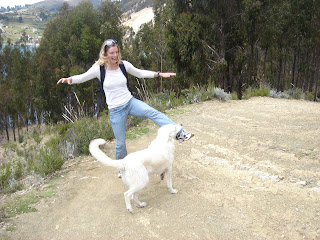Copa-Copacabana!
Hi Guys,
I am writing from Puno, Peru where internet is cheap and traveling easy. We are definitely on the "Gringo Trail" now. To get anywhere you just have to follow the whities with fanny packs and giant backpacks.
So, after Potosí, Mike and I headed to La Paz. La Paz is a bustling big city (we felt remarkably safe however) filled with people going about their business and open air markets everywhere you look. In the shadow of Illimani mountain, La Paz fills a valley, and homes crawl up each of the walls. The most interesting market we saw was the "witches market" where amongst others things, they sell llama fetuses at almost every stall, ranging in scope from keychain sized (with unformed shrimp like tails) to about a foot long. Our guide book said not to take pictures there unfortunately but it was quite a site to see.
We also went to extremely biased, anti-American Coca Museum dedicated to the revered coca leaf. As unbalanced as it was (I guess it is to be expected when it is a museum dealing with a plant that when in drug form is a scourge on (American/western) society) it was very interesting. Did you know for example, that coca paste, the first stage in making cocaine, is made by stomping on the leaves, just like with grapes being made into wine? The coca leaf is also apparently quite nutritious and used, even now, in Coca Cola's secret recipe.
La Paz was a day to relax for us however, so we went and saw the movie 300 (brand new here but I bet it has been out in Canada for quite some time), which Mike has since become obsessed with. I think he knows everything these is to know about it now, from details about the battle of Thermopoli to the actors work out regime. Anyway, as much as we enjoyed our day in La Paz, we raced on to Copacabana...we really have to move now, we only have 2 weeks before we come home!
 Overlooking Copacabana from a pilgrim's lookout on the top of a cerro
Overlooking Copacabana from a pilgrim's lookout on the top of a cerro  Inca temple of Pilco Kaina on the island
Inca temple of Pilco Kaina on the island 
When we made it to the North of the island, we found out there was only one boat leaving for the south that day and we didn't have enough time to see the ruins, the reason we had made the trek. The ruins we didn't get to see are where the Inca's claimed the sun was born. It is too bad but Mike pacified me with the promise of many more ruins to come in Peru. It broke my heart to leave our new found travel companion so I asked if we could take Gringo back to Yumani where I assume his home is. Although the boatman was willing, poor Gringo was too scared of the spaces between the boards on the pier and wouldn't even be bribed by food. However, when the boat finally left, he forgot his fear, and ran out on the pier after us. Poor guy wanted to come. We can only hope that he follows some other tourists back the other direction or makes it back on his own.
From Copacabana we headed to Puno where we have been taking it easy so that Mike recovers from whatever bug he's got. We relaxed all this morning and then went to the floating reed islands, made out Tortora reeds that grow in abundance here. Although extremely comercialized now, the 40 or so man-made floating islands were quite a peculiarity. Each island of up to about 10 families has its own president and the ancestors of the Aymara speaking people who live there now built the islands to flee the conquering Incas. It also worked out rather conveniently when the Spaniards arrived since they managed to avoid working in the mines of Potosí. Now however, they seem to make a living pushing souvenirs on tourists. The islands are anchored but can be moved, joined and separated as need be. They are soft and springy to walk on and apparently have to be constantly maintained as the reeds on the bottom rot away.

A view of a few of the islands
The local version of coke. The colour is a little off-putting (any one take multi-vitamins?), but tastes like the fizzy valentines hearts. Not bad actually.







0 Comments:
Post a Comment
<< Home